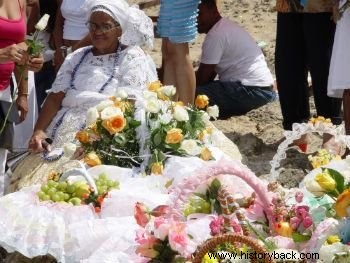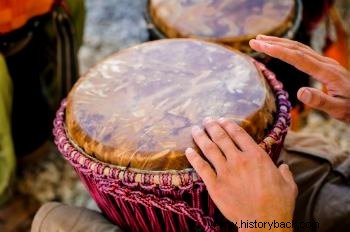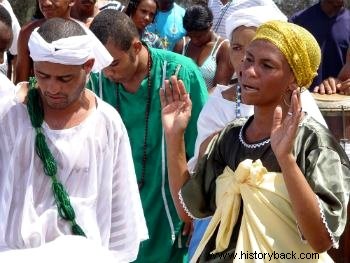The Afro-Brazilian culture dates back to the colonial period, when the transatlantic slave trade forced millions of Africans to come to Brazil. Thus, the largest population of African origin outside Africa was formed.
This culture is marked by its relationship with other cultural references, especially indigenous and European, which is constantly developing in Brazil.
Characteristics of Afro-Brazilian Culture
One of the main characteristics of Afro-Brazilian culture is that there is no cultural homogeneity throughout the national territory.
The distinct origin of the Africans brought to Brazil forced them to appropriate and adapt so that their cultural practices and representations would survive.
Thus, it is common to find the African cultural heritage represented in new cultural practices.
African manifestations, rituals and customs were prohibited. They only stopped being persecuted by the law in the 1930s, during the Estado Novo of Getúlio Vargas.
Thus, they started to be celebrated and valued, until, in 2003, Law nº 10.639 (Lei de Diretrizes e Bases da Educação) was enacted.
This law required that Brazilian elementary and secondary schools have in their curricula the teaching of Afro-Brazilian history and culture.
The two most prominent and influential groups in Brazil are:
- the Bantos , brought from Angola, Congo and Mozambique;
- the Sudanese , from West Africa, Sudan and the Guinea Coast.
It should be noted that the most populated regions with African labor were:Bahia, Pernambuco, Maranhão, Alagoas, Minas Gerais, Rio de Janeiro, Espírito Santo, São Paulo and Rio Grande do Sul.
This was due to the large number of slaves received (Northeast region) or the migration of slaves after the end of the sugarcane cycle (Southeast region).
See also:African LegendsAspects of Afro-Brazilian Culture
From the outset, we must emphasize that Afro-Brazilian culture is a constituent part of Brazilian memory and history and that its aspects overflow the margins of this text.
It composes customs and traditions:mythology, folklore, language (spoken and written), cuisine, music, dance, religion, in short, the Brazilian cultural imagination.
See also:African Art:the cultural wealth of this great continentThe Popular Festivities
 Feast of Yemanja
Feast of Yemanja
Carnival, the biggest Brazilian popular festival, celebrated at the beginning of the year and mobilizing the nation.
The Festa de São Benedito, the main festival of Congado (an expression of Afro-Brazilian culture), celebrated on the weekend after Easter.
And, finally, the Feast of Yemanjá, held on February 2nd.
Discover the History and Origin of Carnival.
Music and Dance
 Djembe, African Drum
Djembe, African Drum
The Afro-Brazilian influence is evident in expressions such as Samba, Jongo, Carimbó, Maxixe, Maculelê, Maracatu. They use a variety of instruments, especially Afoxé, Atabaque, Berimbau and Tambor.
We cannot lose sight of the fact that these musical expressions are also corporeal. They reflect on the ways of dancing, as in the case of Maculelê, a Brazilian folk dance, and samba de roda, a musical variation of samba.
We have other expressions of music and dance such as ritual dances, the creole drum, and more contemporary styles, such as samba-reggae and Bahian axé.
Finally, Capoeira deserves special mention. It is a mixture of dance, music and martial arts banned in Brazil for many years and declared Intangible Cultural Heritage of Humanity in 2014.
The Cuisine
 Acarajé
Acarajé
Cuisine is another typical element of Afro-Brazilian culture. She introduced clay pots, coconut milk, black beans, okra, among many others.
However, the best known foods are those of Bahian cuisine, prepared with palm oil and peppers.
Abará, Vatapá and Acarajé stand out, as well as the Northeastern Quibebe, prepared with dried meat or jerked beef; in addition to the pamonha and coconut sweets
And finally, the best-known Brazilian dish of all:feijoada. It was created by slaves as an appropriation of Portuguese feijoada and produced from meat scraps that planters did not consume.
See also:African masks:importance and meaningsReligion
Candomblé Worship
The Afro-Brazilian religion was characterized by syncretism with Catholicism, where it united aspects of Christianity with its religious traditions.
This was so that they could secretly carry out African religious practices (association of saints with orixás), since conversion was only apparent.
Thus, Batuque, Xambá, Macumba and Umbanda syncretism were born, while some African variations of Quimbanda, Cabula and Candomblé were preserved.
Also read:
- Orixás of Brazil
- Formation of the Brazilian people:history and miscegenationAfoxé
- Black Brazilian Personalities
- Inspiring black women
- Black Movement
- Origin of Black Awareness Day
- Questions about culture

